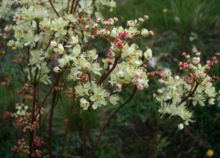Stora Alvaret
Agricultural Landscape of Southern Öland | |
|---|---|
| Criteria | Cultural: iv, v |
| Reference | 968 |
| Inscription | 2000 (24th Session) |
| Coordinates | 56°28′00″N 16°33′00″E / 56.466666666668°N 16.55°E |
Stora Alvaret (Swedish: [ˈstûːra ˈâlːvarɛt]; "the Great Alvar") is an alvar, a barren limestone terrace, in the southern half of the island of Öland, Sweden. Stora Alvaret is a dagger shaped expanse almost 40 kilometres (25 mi) long and about 10 kilometres (6 mi) at the widest north end. The area of this formation exceeds 260 square kilometres (100 sq mi), making it the largest such expanse in Europe and comprising over one fourth of the land area of the island.
Because of the thin soil mantle and high
Stora Alvaret falls within
Geological origins
The limestone plain was created by
Only as recently as 11,000 years ago did the first portions of the island of Öland emerge from the Baltic Sea, after the overpressure of the last glaciers was relieved by melting. Over the next several thousand years, more ice melted and the first wave of large mammals including humans migrated across the ice bridge from the mainland. Finally a thin soil mantle (only two centimetres at the deepest) was formed by plant colonisation of the bare limestone and some wind driven deposition, to create the alvar formation of the present. In many places the limestone has no soil whatsoever upon it.
Prehistoric man
The best known early paleolithic settlement occurs at Alby, situated on the east coast of the island, where excavations have revealed vestiges of wooden huts around a prehistoric lagoon. Artefacts retrieved include evidence of bear, marten, seal and porpoise, but also reveal hunting and gathering technologies through discovery of bone spears, elk antler harpoons and flint.
Evidence of later
Ecology

The first documented scientific study of the
Numerous grasses are found on this alvar including
Practical logistics
Stora Alvaret is bounded on the east, west and south by the perimeter public two-lane highway which circumnavigates the entire island. At several latitudes there are less improved roadways that run east-west and intrude directly through Stora Alvaret. Small villages such as Stora Vickleby, Gettlinge, Grönhögen, Hulterstad, Alby, Triberga and Vället lie at the fringe of Stora Alvaret along the perimeter highway. There are fewer and smaller villages within the alvar expanse itself: Möckelmossen, Solberga and Flisås, for example. Some of the old villages are totally deserted such as Dröstorp. At the extreme south end of Stora Alvaret lies Ottenby, a historic royal game farm and now a nature reserve.
See also
References
- ^ Hakan Sandbring and Martin Borg, Oland: Island of Stone and Green, May, 1997
- ^ Thorsten Jansson, Stora Alvaret, Lenanders Tryckeri, Kalmar, 1999
- ^ K. Borg, U. Näsman, E. Wegraeus, The Excavation of the Eketorp Ring-fort 1964-74. In Eketorp Fortifikation and Settlement on Öland, Sweden, 1976
- ^ Carl Linnaeus, Öländska och Gothländska resa, Stockholm, Sweden (1745)
- ^ C. M. Hogan, The Stora Alvaret of Öland, Lumina Technologies, Aberdeen Library Archives, July 9, 2006



